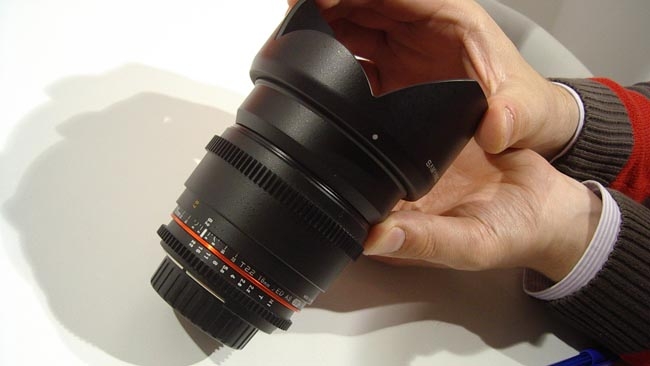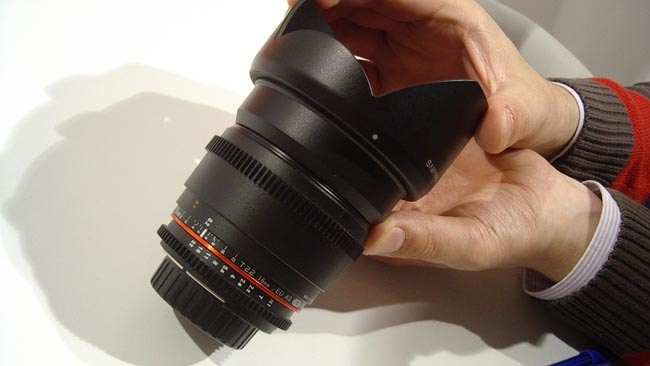
 Samyang Lenses
Samyang Lenses
Phil Rhodes looks at if Samyang's Lenses will be able to compete with in a market with an unbelievable price - eight to twenty times lower than the competition!
A few years ago, it was possible to pick up a full set of ancient stills primes for the cost of a tube of toothpaste, such that one could have them cleaned, polished, lubricated, marked with the appropriate mystic runes and deployed on set. Then, more than a few manufacturers came along and started making big-chip cameras, causing an explosion in value even for lenses with no paint and moss growing inside them. Now, we find ourselves shooting on the most undesirable glass imaginable, stills zooms which are neither fast nor parfocal and with no good external focus control
The obvious solution is to go to Schneider or Zeiss or Cooke and buy a set of PL mount primes, assuming you can find a way to mount them to your camera of choice. The problem is that the price structure used by these sorts of manufacturers will be familiar only if you're used to buying the most difficult, most expensive, wide and fast zooms from the likes of Canon's L series. The rush of big-chip cameras which have created the lens shortage do not exist in the same budgetary sphere as the old guard of cinema lens manufacture. Schneider do now have their Xenon FF range, which are available in PL, Canon or Nikon mount, and designed to cover the 8-perf full-size 35mm stills frame, so you're freed from concerns over coverage if you happen to be a 5D Mk. 3 owner or someone working on something truly exotic, such as a Phantom 65. Schneider's Xenon FF range are also comparatively budget priced, at a mere few thousand dollars a lens. If you've just bought an NEX-EA50, however, and want something a bit better than the rather average zoom that Sony designed for it, the thought of paying more per lens than was paid for the camera is probably going to be discouraging.
Your Options
So, you can either hang around on ebay looking for someone selling off a set of prehistoric Nikons for four times their value, or you can go and talk to Samyang, a Korean lens manufacturer who showed some new additions to their V-DSLR range at IBC. Available in Nikon, Canon, and Sony A or E mounts, the range is clearly (based on equivalent focal length and speed) derived from the company's set of stills-oriented photographic lenses but housed more suitably for the rigours of dramatic filmmaking. There's an 8mm T3.8 fisheye, plus 14mm T3.1, 16mm T2.2, 24mm T1.5, 35mm T1.5 and 85mm T1.5 lenses. All except the 8 and 16 are internal focus, and with clickless aperture settings and manual focus with gears provided to interface control equipment to both. But none of that is really the point; the point is, it's a set of movie primes wherein the most expensive member (the 24mm) is advertised at about UK£550 (US$875).
The price gap between these lenses and their immediate competition is so vast that there really is no competition. It's probably more realistic to consider them as expensive stills lenses, as opposed to cheap movie lenses; as such, they're expensive enough to be really excellent stills primes, although until we can run tests we won't know for sure. In each case they're a few tens of units of currency more expensive than the stills equivalent, which is presumably designed to account for the smaller moviemaking market. Even taking that into account, they're still pricier than the superb 60mm f/2.8 EF-S macro prime made by Canon, so it should not be impossible for the optical quality to be reasonable.
Downsides to the Economic Option?
Without the opportunity to objectively test these lenses, however, it's difficult to be definitive about sharpness, especially given the very – perhaps suspiciously - fast maximum T1.5 aperture of the 25, 35, and 85. What we can be clear about is that they certainly don't have some of the characteristics of things costing eight to twenty times as much, which should be no surprise. They aren't all the same size and shape, and the iris and focus gearing isn't in the same place on all the lenses. This complicates setup of rod-mounted accessories and the mattebox. They're not all internal focus, precluding the use of cheap, lightweight clip-on matteboxs. To conjecture, we can probably also expect to see breathing that would be less tolerable on more expensive glass, assuming they're based closely on designs intended for stills work where a little change in image size when focusing is a perfectly fine tradeoff for sharpness. Whether they're well-matched for colour, bokeh and other optical characteristics is another question that I currently can't answer but will as soon as we can get our hands on a set.
Excellent Value Proposition?
What really matters is whether they're a better deal than existing stills primes, given the inconveniences of using stills lenses for motion picture work. It can be difficult to get good modern stills primes with manual focus as new, so the relevant comparison may be to older stuff that had proper manual focus, and the price of this sort of thing is currently very inflated. As such, Samyang's V-DSLR range would seem to be well-positioned. Lens availability is an important problem that isn't going to be solved, at least in the case of people who paid $3000 for a camera, by lens sets costing $3000 per lens. It is hard to believe, for the money, that these lenses can really be truly excellent, in the sense that things costing many times as much may be excellent, but the overall value proposition may turn out to be very fair. What Samyang is doing is therefore very important. The world needs a source of lenses where the prices are – at least – somewhere in the realm of possibility for individuals. I've certainly been in plenty of situations where I'd have taken them, sight unseen, as a vastly preferable option to the usual motley assortment of Canon zooms so many shoots end up with.
Tags: Technology



Comments